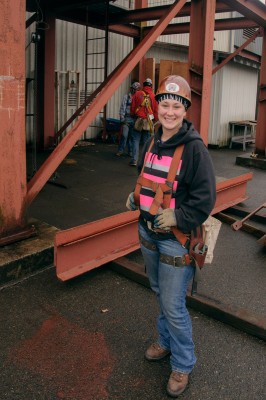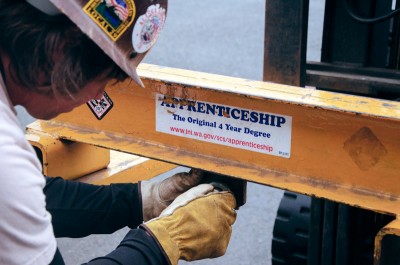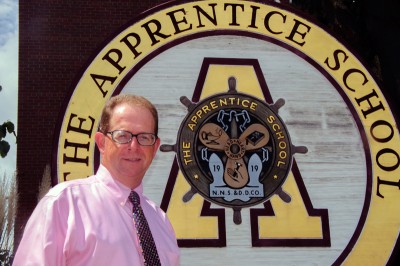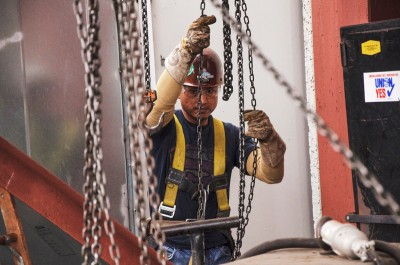Community Colleges, Continuing Education, Domestic, Legislation, Minorities, Required - Written by Wired Academic on Tuesday, December 18, 2012 8:26 - 0 Comments
Age-Old Idea Of Apprenticeship Making A Comeback In Industrial America
 Jesica Bush, 30, who served 7½ years in prison for armed robbery, is now an Ironworkers Local #86 apprentice in Tacoma, Wash., making nearly $25 an hour and earning credits toward a community-college degree. The 5-foot-2 Bush has learned to wrestle 900 lb. girders into place in an apprentice program the Ironworkers revived during a building boom in Seattle. Bush, a seventh-grade dropout, says that in prison, “I had to learn, and I’m still learning. I am driven—and I refuse to lose again.” (Photo by Christopher Connell)
Jesica Bush, 30, who served 7½ years in prison for armed robbery, is now an Ironworkers Local #86 apprentice in Tacoma, Wash., making nearly $25 an hour and earning credits toward a community-college degree. The 5-foot-2 Bush has learned to wrestle 900 lb. girders into place in an apprentice program the Ironworkers revived during a building boom in Seattle. Bush, a seventh-grade dropout, says that in prison, “I had to learn, and I’m still learning. I am driven—and I refuse to lose again.” (Photo by Christopher Connell)
By Christopher Connell, The Hechinger Report
TACOMA, Wash. — Five-foot-two Jesica Bush exudes confidence, whether she’s scribbling notes in a 6:30 a.m. class at Bates Technical College here or wrestling 900-pound girders atop a mock two-story building.
With her blond ponytail tucked inside a brown hardhat, the 30-year-old is an apprentice with the ironworkers’ union, a job that starts at nearly $25 an hour and will lead her in three years to both a journeyman’s card and an associate degree.
But when it took her just six months to complete her GED in Purdy, the instructors asked her to be valedictorian at the graduation ceremony and to start thinking about college. When she got a chance to fight fires with a prison brigade instead of cleaning toilets, she jumped on it and made the discovery that “I loved hard work. I’d never worked a day in my life. You hike up the forest, you chain-saw trees all day. It’s hard—really hard—just like being an ironworker. But I loved coming back and being tired.”
Now Bush is one of 209 people learning the ironworking trade through apprenticeships like this one and others run by the Aerospace Joint Apprenticeship Committee, a state-funded partnership among community colleges, industry and the International Association of Machinists and Aerospace Workers, at a time when skilled workers are needed by Boeing and the rest of the aerospace industry in Seattle and to help build a $4 billion replacement for the floating 520 Bridge over Lake Washington.
An age-old doorway into skilled trades and a middle-class life, the apprenticeship is making a comeback, rebounding after all but disappearing in recent decades in the face of a decline in union membership and dwindling demand for skilled labor. And as the economy changes, today’s apprenticeships combine the chance for workers not only to master skills while earning a paycheck but to get a college degree at the same time.
From the White House to executive suites, and from think tanks to such industry groups as the National Association of Manufacturers, there’s a push to link apprenticeships with conventional education, mostly at community colleges, and produce a better-educated workforce capable of filling the more than 3.6 million skilled jobs the Bureau of Labor Statistics estimates remain vacant in industries such as manufacturing—even at a time when more than triple that number of Americans are looking for work.
 Ironworkers Union Local #86 instructor Kelly Graves readies a piece of equipment at the union’s training center at Bates Technical College in Tacoma, Wash. The four-year apprenticeship now comes with the opportunity to earn an associate degree. “The more education you have, the better off you are,” says Graves. “The trade is gearing towards that.” (Photo by Christopher Connell)
Ironworkers Union Local #86 instructor Kelly Graves readies a piece of equipment at the union’s training center at Bates Technical College in Tacoma, Wash. The four-year apprenticeship now comes with the opportunity to earn an associate degree. “The more education you have, the better off you are,” says Graves. “The trade is gearing towards that.” (Photo by Christopher Connell)
Higher education, advocates say, can not only provide these newly minted workers with the critical-thinking skills they need for today’s jobs, but also leave them better prepared and more appealing to employers the next time things get tough.
“What works so well about apprenticeships is that workers can gain tailored skills for the workplace along with critical academic learning, all while they earn a paycheck,” says Sen. Patty Murray (D-Washington), a champion of federal support for apprenticeship programs.
What makes them a model, Murray said at a U.S. Department of Labor ceremony marking this year’s 75th anniversary of the National Apprenticeship Act, are those paychecks, plus the programs’ reliance on strong public and private partnerships and the combination of academic and on-the-job learning.
Machinists these days have to operate sophisticated, computer-numerical-controlled equipment like the $3 million Makino vertical machining center that Seattle apprentice Irwin Downes has learned to run at JWD Machine in Fife, Wash. The company sent Downes and two other apprentices to Ohio to learn how to run the super lathe, which can cut titanium parts on several axes at once under high heat and jet sprays. Now the three are teaching the factory’s other 42 machinists how to use the time-saving machine to make critical parts for the aerospace industry.
Downes, who is 24, also spends four hours in class one night a week at Bates Technical College. “I knew my feeds and speeds for cutting aluminum, but why is it that way?” says Downes, who previously worked in a Chinese fast-food restaurant for a year after high school. “At Bates, they break it down into a math formula and show us where the numbers come from.”
 The Newport News Shipbuilding Apprentice School in Virginia gets more than 6,000 applications each year for its 260 openings. New apprentices spend two full days in college classes each week while earning more than $30,000 a year. Director Everett Jordan, an alumnus (he was a shipfitter), says the college classes add “a critical dimension” to the workers’ skills at the shipyard that builds nuclear aircraft carriers and submarines for the U.S. Navy. (Photo by Christopher Connell)
The Newport News Shipbuilding Apprentice School in Virginia gets more than 6,000 applications each year for its 260 openings. New apprentices spend two full days in college classes each week while earning more than $30,000 a year. Director Everett Jordan, an alumnus (he was a shipfitter), says the college classes add “a critical dimension” to the workers’ skills at the shipyard that builds nuclear aircraft carriers and submarines for the U.S. Navy. (Photo by Christopher Connell)
Across the country in Virginia, at the sprawling Newport News Shipyard on the waterfront near where the James River spills into Chesapeake Bay, applications to the apprenticeship program have skyrocketed from barely 540 a dozen years ago to a record 6,300 this year. New apprentices spend two full days each week in college classes, while earning more than $30,000 to start and upwards of $50,000 by their fourth year. They spend the rest of the week on the waterfront learning one of 17 trades and helping build and repair the nation’s aircraft carriers and nuclear submarines.
The best move on to advanced classes from which almost half will graduate with an associate degree from nearby Thomas Nelson Community College or Tidewater Community College, which teach some courses inside the shipyard gates and others back on their own campuses. The shipyard’s Apprentice School has its own 17-member faculty as well as nearly 70 craft instructors. Of those 6,300 applicants, it takes 260 new apprentices each year—making it more selective than Harvard, Yale and Princeton.
The shipyard, owned by Huntington Ingalls Industries, also looks to the Apprentice School for future supervisors, managers and executives. Danny Hunley, who enrolled as an apprentice welder at age 19 in 1974 and is now vice president of operations, says that “human supply chain” is particularly reliant on the community colleges.
“We invest heavily in community colleges, not just for workforce development but for education of our employees,” says Hunley. “We rely on a lifetime of learning to prepare our people to create the product that we sell that no one else can.”
Hunley says he hopes that when the Apprentice School moves from its World War II-era brick building into a planned glass-and-steel showcase in downtown Newport News, it will even begin to offer bachelor’s degrees.
Malachi Underwood, 27, an apprentice in the foundry shop, came to the shipyard in 2010 after being laid off from a job making wheels for railroad freight cars. “The things you do in the classroom here relate to what you do every day on the job. They make them real life,” says Underwood, who was recently tapped to leave the foundry and become a nuclear test technician.
Everett Jordan, director of the Apprentice School and, like Hunley, an alumnus (he was a shipfitter), says the complex theory classes that apprentices take bring “a critical dimension to our education here.” Adds training manager David Tilman: “If you’re taking AC/DC theory as a freshman in college [elsewhere], you’re putting together little boards. When you’re doing it here, you’re putting together nuclear submarines.”
Conversely, employers say the instruction their apprentices get in college classes is broader than what new workers can learn on the job alone. The colleges typically work with local industry to design their classroom programs.
Apprentice ironworkers from Local #86 with their instructors on a steel scaffolding where they learn their craft at Bates Technical College in Tacoma, Wash. The apprentices, who start at nearly $25 an hour, are among more than 200 whom the union is training as demand for them in the Seattle area picks up after a two-year lull. The apprentices earn college credit for the classes at Bates. (Photo by Christopher Connell)
“Not only is the curriculum structured, but it helps the company build that apprentice’s skill in all facets,” says Jason Mohon, manufacturing director for JWD Machine. “Historically, if you were just an operator or a machinist out on the floor, you might find yourself spending years focusing on one task. This helps the company open their eyes and cross-train them.”
The same is true of the 6:30 a.m.-to-3:30 p.m. classes that the ironworker apprentices take in Tacoma, which occupy one month each year during their four-year apprenticeships. At the job sites where they spend the other 11 months, much of the trainees’ time may be spent carrying or tying rebar, or doing other hard, physical labor, rather than the more complicated work of following codes and blueprints.
Some foremen and journeymen “have no problem explaining things so the apprentices build up knowledge as they go, but some do not,” says instructor Kelly Graves. He tells the apprentices that if they want to be superintendents, they’ll need college degrees. “The more education you have, the better off you are,” he says.
Washington Gov. Chris Gregoire and the state legislature came up with $3 million to create the aerospace apprenticeship program in 2008, at a time of near-panic among employers about the aging of their skilled workers. Half of Boeing engineers are eligible to retire by 2015, and two-thirds of the company’s entire workforce is within a decade of retirement age.
 An Ironworkers Union Local #86 apprentice prepares to hoist a section of a steel beam to the second story of the building skeleton they practice on at the end of a 9-hour class day at Bates Technical College in Tacoma, Wash., that begins at 6:30 a.m. The apprentices, paid nearly $25 an hour to start, earn credits toward an associate degree while they learn the trade. (Photo by Christopher Connell)
An Ironworkers Union Local #86 apprentice prepares to hoist a section of a steel beam to the second story of the building skeleton they practice on at the end of a 9-hour class day at Bates Technical College in Tacoma, Wash., that begins at 6:30 a.m. The apprentices, paid nearly $25 an hour to start, earn credits toward an associate degree while they learn the trade. (Photo by Christopher Connell)
Yet employers have their work cut out to convince a new generation to enter these trades, says Laura Hopkins, the program’s executive director. For them, the promise of a college degree can be an inducement.
“In this day and age, if I’m trying to recruit young people, we have to have a college degree attached,” Hopkins says. “We have to convince their counselors and teachers and parents as well that this is a good career opportunity for them and that if the economy shifts and their industry goes down, they can move on to something else with that college degree.”
If apprentices have a college degree and work as machinists for a while but then decide they want to go into engineering, “they now have the opportunity to do that without starting from square zero,” says Hopkins, herself a former Boeing aircraft mechanic and dean at South Seattle Community College. “The more pathways we create for folks to go into these different careers, the better it is for everybody.”
Back at Bates, Jesica Bush is convinced she’s found the right calling. She wants to become a construction supervisor eventually and instruct apprentices herself.
“I’m a bossy person. I envision me running something sooner or later,” Bates says. “I grew up in prison. That’s where I got educated. I had to learn, and I’m still learning. I am driven—and I refuse to lose again.”
This story was produced by The Hechinger Report, a non-profit journalism organization housed at Columbia University in New York City. This story also appeared on NBCNews.com on December 6, 2012.
Campus Buzz
We welcome Tips & Pitches
Latest WA Original Features
-
Open University Enters Battle Of The MOOCs, Launches “FutureLearn”
-
Alvaro Salas As A Case Study In Crowd-Funding An Ivy-League Education
-
Jonathan Mugan: How To Build A Free Computer Within A Computer For Your Child
-
WGU Texas & Three Community Colleges Develop Individual-Paced College Courses
-
Language Learning: Berlin’s Babbel.com Builds Towering Growth Trajectory
Paul Glader, Managing Editor
@paulglader
Eleni Glader, Policy Editor
Elbert Chu, Innovation Editor
@elbertchu
Biagio Arobba, Web Developer
@barobba
Ravi Kumar, Reporter & Social Media Editor
@ravinepal
Contributors:
Michael B. Horn
@michaelbhorn
Derek Reed
@derekreed
Annie Murphy Paul
@AnnieMurphyPaul
Frank Catalano
@FrankCatalano
Ryan Craig
@UniVenturesFund
Jonathan Mugan
@JMugan
Terry Heick
@TeachThought
Alison Anderson
@tedrosececi

The Pulitzer Prize winning investigation newsroom digs into for-profit education.
-
Most Viewed
- Pearson Llc + Google Expands LMS Business With "OpenClass" System
- Guest Column: Why Steve Jobs would have loved digital learning
- Inside Ashford University: A former staffer talks to WiredAcademic
- Citing IT Skills Shortage, IBM Wants To Expand Presence At Universities
- Online Educa: A Closer Look At 8 Virtual K-12 Schools In Europe
-
MARKET INTRADAY SNAPSHOT
- Education & Tech Companies We Follow
| APEI | 35.62 |  -0.36 -0.36 |  -1.00% -1.00% | ||
| APOL | 20.39 |  +0.14 +0.14 |  +0.69% +0.69% | ||
| AAPL | 513.51 |  -6.658 -6.658 |  -1.28% -1.28% | ||
| BPI | 10.1001 |  -0.2899 -0.2899 |  -2.79% -2.79% | ||
| CAST | 0.085 |  -0.005 -0.005 |  -5.56% -5.56% | ||
| CECO | 3.31 |  +0.04 +0.04 |  +1.22% +1.22% | ||
| COCO | 2.43 |  -0.08 -0.08 |  -3.19% -3.19% | ||
| CPLA | 27.8999 |  -0.1701 -0.1701 |  -0.61% -0.61% | ||
| DV | 23.00 |  -0.26 -0.26 |  -1.12% -1.12% | ||
| EDMC | 4.5812 |  -0.2688 -0.2688 |  -5.54% -5.54% | ||
| ESI | 17.58 |  +0.52 +0.52 |  +3.05% +3.05% | ||
| GOOG | 705.558 |  -3.942 -3.942 |  -0.56% -0.56% | ||
| LINC | 5.76 |  +0.08 +0.08 |  +1.41% +1.41% | ||
| LOPE | 22.88 |  -0.74 -0.74 |  -3.13% -3.13% | ||
| PEDH | 0.60 |  +0.43 +0.43 |  +252.94% +252.94% | ||
| PSO | 19.39 |  -0.02 -0.02 |  -0.10% -0.10% | ||
| SABA | 8.41 |  -0.04 -0.04 |  -0.47% -0.47% | ||
| SCHL | 29.038 |  +0.088 +0.088 |  +0.30% +0.30% | ||
| STRA | 57.73 |  +0.07 +0.07 |  +0.12% +0.12% | ||
| WPO | 358.56 |  -2.20 -2.20 |  -0.61% -0.61% |
Blended Learning, Domestic, For-Profit, Graduate, Personalized Learning, Required, Universities & Colleges - Dec 25, 2012 6:00 - 0 Comments
Infographic: A Graphical Profile Of Today’s Online College Student
More In For-Profit
- Infographic: A Comparison Of For-Profits v. Non-Profit Online College Data
- Opinion: How “Shareholder Value” Is Destroying For-Profit, Career Colleges
- Avenues: The World School Opens To Fanfare & Critics Of Elitist High-Tech
- University of Phoenix Is Biggest Spender on Google, $400k Per Day
- Heard: Whistleblower Pops Lid On Deceit At EDMC Schools
Cost of Education Domestic Education Quality Ethics For-Profit Friend, Fraud, or Fishy Gainful Employment Lawsuits & Legal Minorities Regulatory Required Retention Rates Student Loans Universities & Colleges
Domestic, Ethics, K-12, Opinion, Parents, Regulatory, Required, Technology - Dec 25, 2012 6:00 - 0 Comments
Anne Collier: Parenting In 2013 & What Net Privacy’s Got To Do With It
More In Technology
- Terry Heick: The iPad’s Past, Present & Future In Learning Environments
- Tom Vander Ark: Wunderkind MOOCs Still A Non-Consumption Trend
- Tom Vander Ark: Education’s 5 Megatrends Of 2012
- Jonathan Mugan: Teaching Your Child To Hack Math
- Guest Column: Move Over Generation X & Y, Say Hello To Generation Z
Cost of Education, Domestic, For-Profit, Friend, Fraud, or Fishy, Graduation Rates, Infographics, Recruitment, Required, Universities & Colleges - Dec 18, 2012 6:00 - 0 Comments
Infographic: A Comparison Of For-Profits v. Non-Profit Online College Data
More In Friend, Fraud, or Fishy
- Opinion: How “Shareholder Value” Is Destroying For-Profit, Career Colleges
- The Incredible Expansion Of Charter Schools In American School Districts
- Heard: Whistleblower Pops Lid On Deceit At EDMC Schools
- For-Profit Career Education Corp. To Close 23 Campuses
- Opinion: How The GI Bill Fails Soldiers And Lines For-Profit College Pockets
Domestic Friend, Fraud, or Fishy Opinion Recruitment Regulatory Required Universities & Colleges


Leave a Reply